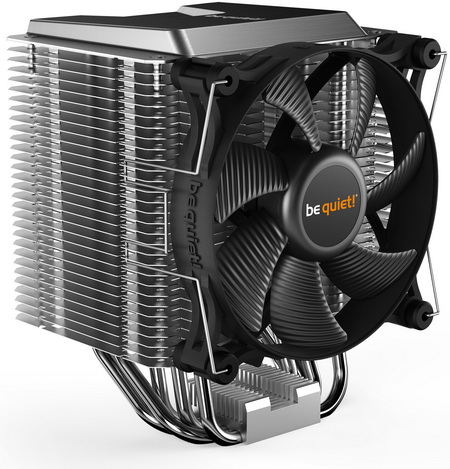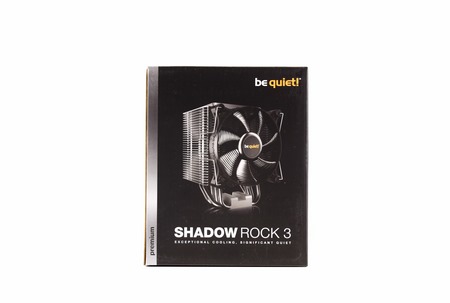INTRODUCTION

Any manufacturer with a successful product line has no reason to move away from it (or even introduce a new one), quite the contrary actually and so it's normal to see new products get added to that said line or lines. The same of course applies for CPU cooler manufacturers so from time to time new models with improved specifications, either in terms of the heatsink (total fin surface, number and thickness of heatpipes and base type) or the fan and/or fans used (airflow and air pressure levels), get added in their popular lines. Be quiet! has several such lines including the mid-range Shadow Rock line and today with us we have its latest addition, the Shadow Rock 3.
be quiet! is a premium brand of power supplies, PC cases and cooling solutions for desktop PCs. The products of be quiet! offer legendary quiet operation and first-class performance thanks the passion for quality and precision. Attention to detail is the key to perfection. Which is why our very own experts lead product conception, design and quality control from our headquarters in Germany. be quiet! sticks to its name: More than 15 years experience in the field of noise reduction and silence make be quiet! products probably the most silent ones on the market.
The last CPU cooler by be quiet! in the Shadow Rock line was the top-down (C-type) Shadow Rock TF 2 model but the predecessor of the new Shadow Rock 3 model is actually the tower-design (U-type) Shadow Rock 2 model released back in 2013. Yes, it took be quiet! roughly 7 years to release its successor but the end result is very different so aside the brushed aluminum top cover (mostly for looks) it also features an asymmetrical design (zero interference model), five 6mm nickel plated heatpipes (compared to the four 8mm ones of its predecessor), heatpipe direct touch (H.D.T) base and 30 aluminum fins (as opposed to the 51 of the previous model). Of course, the fan model is also different so the Shadow Rock 3 CPU cooler comes bundled with a Shadow Wings 2 120mm PWM model (1600RPM/24.4dBA - 1600RPM/24.9dBA for the Pure Wings 2 fan used in the Shadow Rock 2) for which we don't have all the numbers (like airflow and air pressure). All of the above give the Shadow Rock 3 a TDP (thermal design power) of 190W, 10W over that of its predecessor.
SPECIFICATIONS AND FEATURES

PACKAGING AND CONTENTS
Just like with previous coolers by be quiet! the Shadow Rock 3 arrived inside a black box that has a large product picture at the front next to the company logo.
If you'd like more info on the product just scan the 2D barcode located on the left side of the box with your smart phone or tablet.
The specifications table is printed on the right side of the box right over the cooler's TDP and beneath a few words about be quiet!.
Two pictures placed at the rear of the box are used to showcase the main product features.
Both the fan and the bundle are placed in secondary cardboard boxes next to the heatsink.
Be quiet! ships the Shadow Rock 3 with 4 fan clips (can add a 2nd fan in push & pull), long Philips screwdriver, small tube with thermal grease, Intel backplate, mounting bar, user manual, warranty information and mounting sets for both Intel LGA 1150/1151/1155/1156/1366/2011/2011-3/2066 and AMD AM3/AM3+/AM4 mainboards.
THE SHADOW ROCK 3
Standing 163mm tall, 96mm long and 130mm wide the 716g heavy Shadow Rock 3 CPU cooler is a mid-sized model.
The top brushed aluminum plate is partially painted black, has the company logo on it and as for the hole well you will need to use the bundled screwdriver here to mount the cooler.
By using 30 aluminum fins the Shadow Rock 3 weighs a lot less compared to its predecessor (thus less force on your mainboard if you use a regular case).
The asymmetrical design gives you a clearance of 40mm at the rear (at the front you can always move the fan upwards).
This time over be quiet! used five 6mm nickel plated heatpipes for their newest CPU cooler.
It's somewhat refreshing to see be quite! use an heatpipe direct touch base with one of their coolers.
As usual be quiet! equipped the cooler with a "custom" version of one of their Shadow Wings 2 PWM fan but aside its max speed of 1600RPM and its max noise levels of 24.4dBA we don't know much about it.
Round rubber anti-vibration pads are also located on all 4 corners of the fan.
With the Shadow Wings 2 PWM fan mounted the Shadow Rock 3 is now 121mm long and weighs roughly 855g.
TEST BED


TESTING METHODOLOGY
We always take things quite seriously when it comes to work so just like with the previous LGA1366 database we will not be testing each CPU Cooler on its own and with different ambient temperature levels and thus we can actually have yet another valid CPU Cooler database. Testing a CPU Cooler automatically means that you need to know where it stands against the immediate competition and to accomplish that we have spent both money and time through the years, something that we plan to continue to do so in order to get the most accurate results for the end consumers who read these lines. Every CPU cooler in this database is tested with the bundled 140mm/120mm/92mm/80mm fans while working at both idle speed and 100% of their speeds for all the temperature tests. CPU Coolers that do not come bundled with a fan/s are measured using a Noctua fan (size dependent on the model) to test for the temperature tests but due to the lack of a stock fan dBA level tests are obviously skipped. Single (120/140mm) watercooling solutions are tested with the radiator mounted at the rear of our test rig while dual/triple/quad (240/260/280/360/420/480/560mm) solutions with the radiator mounted at the top. For the dBA tests every cooler in the database was measured both while on idle mode or with the fan controller in the minimum setting and while on extreme load or with the fan controller all the way to the highest possible setting (PWM fans do that on their own without our intervention). Every single test takes place in a temperature controlled room of 23 degrees Celsius Ambient Temp with the help of two AC units placed diagonally inside the room. The Arctic Silver 5 thermal paste is used with every CPU Cooler in our latest LGA2011 database (although initially this was not the plan, we had to change things to get the most accurate results). Finally, it's very important to point out that just because a CPU Cooler is better than another when tested with our test rig that does not necessarily mean that the same performance differences will apply 100% for other CPU models and in other situations (such as different ambient temps and system configurations).
To successfully record the load temperatures, we use the latest OCCT application for around 6-10 minutes to push the processor to its limits and after that is done and the temperatures are recorded, we wait for about 10-20 minutes for the CPU to cool down and record the idle temperatures. This is done to allow time for the thermal conductive material to achieve the optimal performance level. Same procedure is then repeated with the Passmark BurnIn Test as a failsafe just in case the OCCT results are wrong. This procedure is more time consuming than the usual peltier/thermometer tests but this way not only can we deliver real world results to our readers based on real CPUs but we can also triple check the results using a variety of programs. Last but not least the temperatures were recorded using both the latest versions of AIDA64 and RealTemp while the noise level tests are performed using a high precision ExTech HD600 Decibel Meter placed about 10-15cm above the CPU Cooler. Still although the same testing procedure applies to all units do take into consideration that unlike the official numbers which are measured in special noise isolated labs with just the fans here, we also have both the rest of the cooler and the rest of the system (although all system fans are turned off when recording noise levels).
TEST RESULTS


CONCLUSION

The improvements be quiet! implemented in their latest Shadow Rock 3 CPU cooler seem to have paid off since even though it's smaller compared to its predecessor our results showed roughly 5 degrees difference between them (a more or less 10% improvement). On top of that not only did the Shadow Rock 3 surpass the Mugen 5 ARGB Plus (even by just a little) but it also matched the performance of the Fuma 2 model (both dual-fan models by Scythe). Now I'm fully aware that the Shadow Rock 3 may not be the highest quality or the best looking model of theirs to date (their Dark Rock line is my favourite plus for some people RGB lighting is a one way lately) but producing such cooling efficiency with such low noise is not something we see often, even more so from a mid-range model. Also, the somewhat limited compatibility with AMD CPU’s may disappoint some potential buyers but it is what it is.
The Shadow Rock 3 CPU Cooler by be quiet! was officially released 2 days ago and currently retails for USD49.90 inside the USA (Newegg.com) and for 52.66Euros inside the EU (Amazon.de) a price tag which is extremely tempting for the performance you’ll be getting in return. Overall the be quiet! Shadow Rock 3 may not be the best model out in the market today but for people who care only about performance and aren’t willing to spend much in order to get it this represents a great choice and for that it gets our Golden Award.

PROS
- Very Good Cooling Efficiency
- Design (Zero Interference Model)
- Price
- Dual Fan Solution
- Bundle
- 3 Years Warranty
CONS
- Looks (For Some)
- AMD Compatibility

 O-Sense
O-Sense






















.png)

